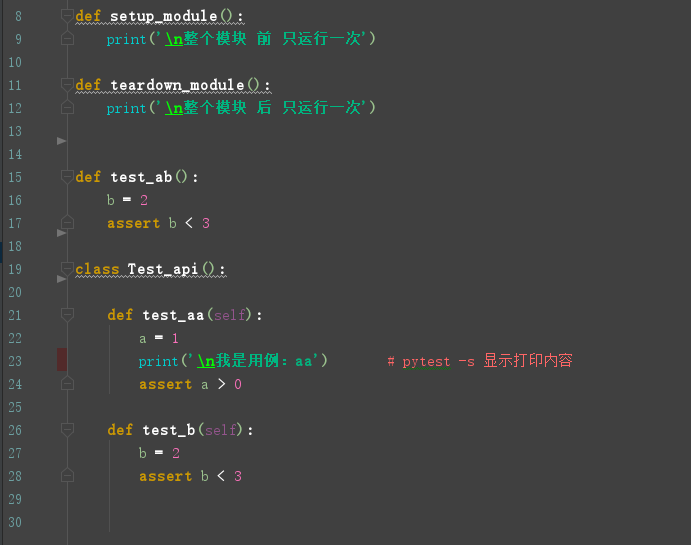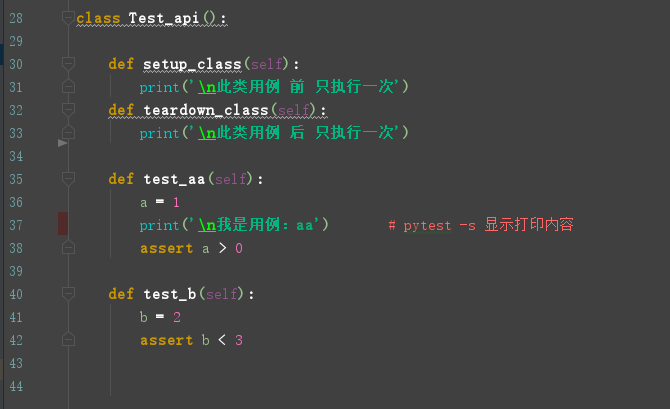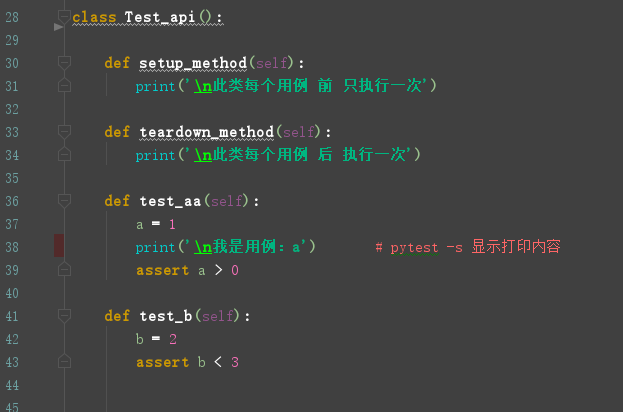前言
我们都知道在自动化测试中都会用到前后置,pytest 相比 unittest 无论是前后置还是插件等都灵活了许多,还能自己用 fixture 来定义。(甩 unttest 半条街?)
首先了解一下,用例运行前后置级别如下:
- 模块级:全局的,整个模块开只运行一次,优先于测试用例。
- 类级别:定义在类里面,只针对此类生效。类似unittest的cls装饰器
- 函数级:只对函数生效,类下面的函数不生效。
- 方法级:定义在类里面,每个用例都执行一次
一、setup、teardown级别
1、模块级别:setup_module、teardown_module
全局的,整个模块开只运行一次,优先于测试用例。

2、类级别:setup_class、teardown_class
类级别:定义在类里面,只针对此类生效。类似unittest的cls装饰器

3、函数级:setup_function、teardown_function
函数级:只对函数生效,类下面的函数不生效。

4、方法级:setup_method、teardown_method
方法级:定义在类里面的函数,也叫方法,每个用例都执行一次

最后全部执行打印,代码:
def setup_module(): print(' 整个模块 前 只运行一次') def teardown_module(): print(' 整个模块 后 只运行一次') def setup_function(): print(' 不在类中的函数,每个用例 前 只运行一次') def teardown_function(): print(' 不在类中的函数,每个用例 后 只运行一次') def test_ab(): b = 2 assert b < 3 def test_aba(): b = 2 assert b < 3 class Test_api(): def setup_class(self): print(' 此类用例 前 只执行一次') def teardown_class(self): print(' 此类用例 后 只执行一次') def setup_method(self): print(' 此类每个用例 前 只执行一次') def teardown_method(self): print(' 此类每个用例 后 执行一次') def test_aa(self): a = 1 print(' 我是用例:a') # pytest -s 显示打印内容 assert a > 0 def test_b(self): b = 2 assert b < 3

二、fixture简单使用
1、Fixture 其实就是自定义 pytest 执行用例前置和后置操作,首先创建 conftest.py 文件 (规定此命名)
2、导入 pytest 模块,运用 pytest.fixture 装饰器,默认级别为:函数级,如图二源码


3、其它用例文件调用即可,如下定义一个函数,继承 conftest.py 文件里的 setup_login 函数即可调用:
''' 运用 fixtures 定义的顺序 '''
def test_001(setup_login):
print('
上面是登录,我现在点击进入home')

4、cmd 运行结果如下:
先执行了 conftest.py 文件里的 setup_login 函数,再执行运行的用例.py文件;
G:python_studystudypytest_demostudy>pytest -s test_fixture.py ================================================= test session starts ================================================= platform win32 -- Python 3.6.5, pytest-3.6.3, py-1.8.0, pluggy-0.6.0 rootdir: G:python_studystudypytest_demostudy, inifile: collected 1 item test_fixture.py 先执行登录 上面是登录,我现在点击进入home . ============================================== 1 passed in 0.07 seconds ===============================================
5、conftest.py 文件,自定义函数后置操作:yield

G:python_studystudypytest_demostudy>pytest -s test_fixture.py ================================================= test session starts ================================================= platform win32 -- Python 3.6.5, pytest-3.6.3, py-1.8.0, pluggy-0.6.0 rootdir: G:python_studystudypytest_demostudy, inifile: collected 1 item test_fixture.py 先执行登录 上面是登录,我现在点击进入home . 测试数据最后执行清理 ============================================== 1 passed in 0.06 seconds ===============================================
6、多个自定义函数和全局级别展示:(全局的比如用于登录获取到token其他用例模块就不需要再登录了)
①conftest.py 文件代码如下:
import pytest @pytest.fixture(scope='session') # scope='session' 任何文件共享 def setu_login(): print(' 用例先登录') @pytest.fixture() def open_html(): print(' 打开页面') # 后置操作 yield print(' 测试数据最后执行清理')
②用例文件代码如下:
def test_001(setu_login): print(' 上面是登录,我现在点击进入home') def test_002(open_html): print(' 没登录,打开html') def test_003(setu_login, open_html): print(' 登录后,打开html') def test_data(open_html): print('测试数据1') def test_data1(open_html): print('测试数据122')
③cmd 运行结果:
G:python_studystudypytest_demostudy>pytest -s test_fixture.py ================================================= test session starts ================================================= platform win32 -- Python 3.6.5, pytest-3.6.3, py-1.8.0, pluggy-0.6.0 rootdir: G:python_studystudypytest_demostudy, inifile: collected 5 items test_fixture.py 用例先登录 上面是登录,我现在点击进入home . 打开页面 没登录,打开html . 测试数据最后执行清理 打开页面 登录后,打开html . 测试数据最后执行清理 打开页面 测试数据1 . 测试数据最后执行清理 打开页面 测试数据122 . 测试数据最后执行清理 ============================================== 5 passed in 0.06 seconds ===============================================

看完之后,有没有甩 unittest 框架半条街你说了算?pytest 成为了目前主流的任意玩框架。
对于运行用例级别都是setup_xx,teartown_xx,后面接module、class是不是很好记呢?欢迎来QQ交流群:482713805